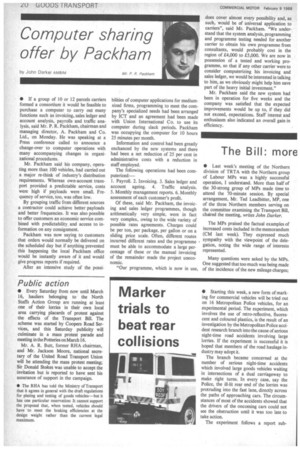Computer sharing offer by Packham
Page 22

If you've noticed an error in this article please click here to report it so we can fix it.
• If a group of 10 or 12 parcels carriers formed a consortium it would be feasible to purchase a computer to carry out many functions such as invoicing, sales ledger and account analysis, payrolls and traffic analysis, said Mr. P. R. Packham, chairman and managing director, A. Packham and Co. Ltd., on Monday. He was speaking at a Press conference called to announce a change-over to computer operations with many accompanying changes in organizational procedures.
Mr. Packham said his company, operating more than 100 vehicles, had carried out a major re-think of industry's distribution requirements. Whereas own-account transport provided a predictable service, costs were high if payloads were small. Frequency of service, too, was often low.
By grouping traffic from different sources a contractor could achieve better payloads and better frequencies. It was also possible to offer customers an economic service combined with predictability and access to information on any consignment.
Packham was now saying to customers that orders would normally be delivered on the scheduled day but if anything prevented this happening the local Packham office would be instantly aware of it and would give progress reports if required.
After an intensive study of the possi bilities of computer applications for mediumsized firms, programming to meet the company's specialized needs had been arranged by ICT and an agreement had been made with Union International Co. to use its computer during slack periods, Packham was occupying the computer for 10 hours 25 minutes per month.
Information and control had been greatly enchanced by the new systems and there had been a net reduction of 25 per cent in administrative costs with a reduction in staff employed.
The following operations had been computerized: 1. Payroll. 2. Invoicing. 3. Sales ledger and account ageing. 4. Traffic analysis. 5. Monthly management reports. 6. Monthly assessment of each customer's profit.
Of these, said Mr. Packham, the invoicing and sales ledger programmes, though arithmetically very simple, were in fact very complex, owing to the wide variety of possible rates agreements. Charges could be per ton, per package, per gallon or on a sliding price scale. Often, different routes incurred different rates and the programme must be able to accommodate a large percentage of these or the manual invoicing of the remainder made the project uneconomic.
"Our programme, which is now in use, does cover almost every possibility and, as such, would be of universal application to carriers", said Mr. Packham. "We understand that the system analysis, programming and programme testing needed for another carrier to obtain his own programme from consultants, would probably cost in the region of £4,000 to £5,000. We are now in possession of a tested and working programme, so that if any other carrier were to consider computerizing his invoicing and sales ledger, we would be interested in talking to him, as we obviously might help him save part of the heavy initial investment."
Mr. Packham said the new system had been in operation for five weeks and the company was satisfied that the expected improvements would be up to, if they did not exceed, expectations. Staff interest and enthusiasm also indicated an overall gain in efficiency.




































































































